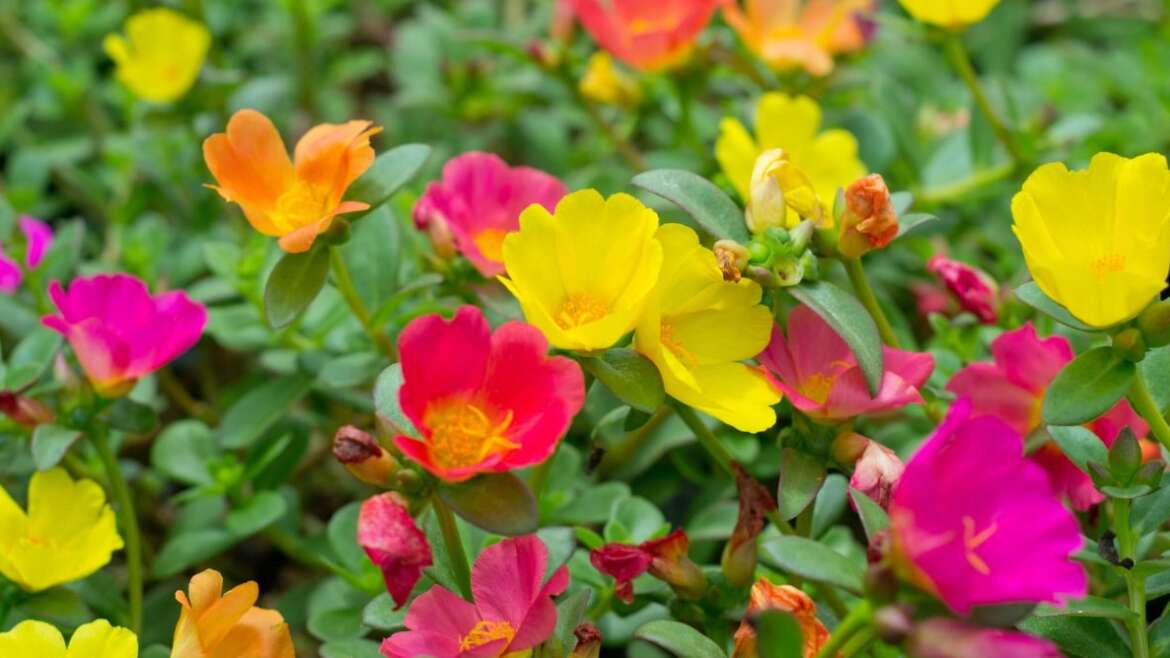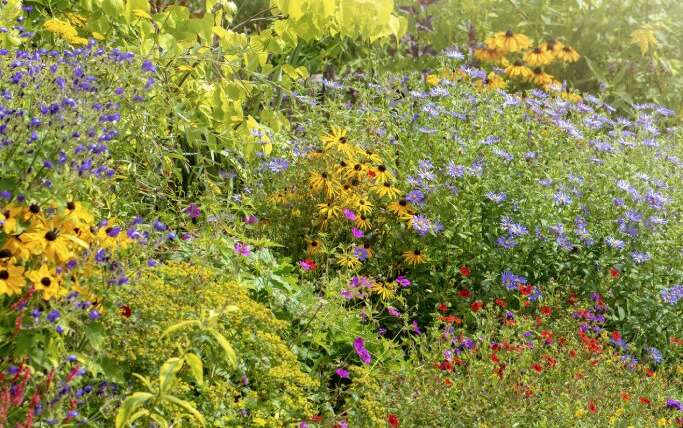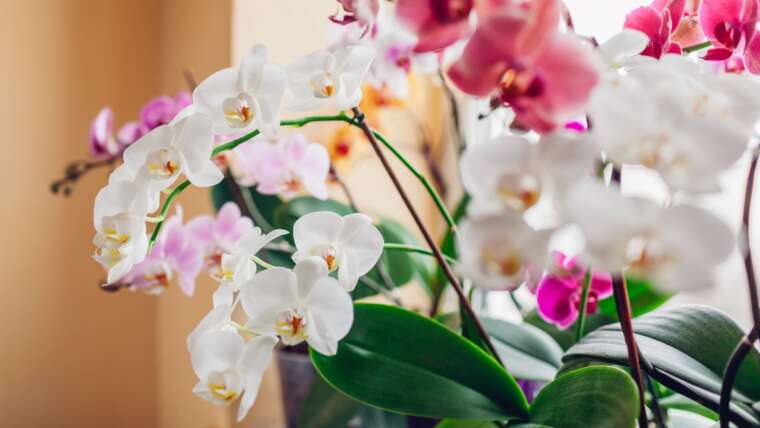What Are Moss Roses?
Despite their name, moss roses are not true roses. Although many cultivars produce flowers that resemble a rose, these colorful blooms actually grow on succulent plants.
Moss roses, or Portulaca grandiflora, are also known by the common names eleven o’clock, Mexican rose, sun rose, table rose, rock rose, and moss rose purslane. It is a small but fast-growing annual plant that makes an excellent ground cover.
This small flowering succulent is particularly heat and drought-tolerant, which also makes it a great addition to a rock garden or xeriscaping. The flowers will attract bees, butterflies, and many other beneficial pollinators as well. Many cultivars boast showy double flowers, which makes them equally attractive to the human eye as well.
Native Area
This plant flourishes in challenging locations where others struggle.
Moss roses are native to southern Brazil, Argentina, and Uruguay. In areas where there are frost-free climates, they will grow wild and readily self-seed. In their native area, they thrive in the heat and low humidity.
They prefer rocky and sandy soils and can be found growing between the stones of old abandoned architecture. For this reason, they can also be found growing in the cracks between the sidewalk without any human intervention at all.
Characteristics
 These plants produce small rose-like flowers in various colors.
These plants produce small rose-like flowers in various colors.
The fleshy succulent leaves can be thin and narrow or wide and oblong, depending on the variety. This low-growing plant will grow to a height of six inches upon maturity and sprawls up to two feet.
The flowers that resemble small roses appear in many different colors, including orange, white, pink, yellow, and red. Moss roses form a thick carpet of beautiful small rose-like flowers that begin blooming in the heat of the summer and into the early fall.
As mentioned above, they will readily self-seed and can sprout again the following season. Collecting the seeds is easy if you want to spread them around your garden in a more intentional manner.
In mid-autumn, the flower heads will begin to fade and die back, which will reveal the formation of a seed pod. Once the pods have completely dried, you can pull them off with your hands. Rub the pods between your fingers to break them open, and you will find plenty of tiny black seeds for replanting from seed next year!
Reasons to Start From Seed
 Starting seeds is a cost-effective and educational gardening practice.
Starting seeds is a cost-effective and educational gardening practice.
- It’s cost-effective. You will always get more bang for your buck when buying a packet of seeds. One packet will yield many plants for the same cost as buying a single plant from the nursery. Plus, if you already have moss roses growing in your garden, then you already have a free and endless source of seeds!
- For the learning experience! Starting seeds is a great learning experience for kids and adult gardeners alike. You’ll get to sprinkle the tiny, delicate seeds onto the soil, and with the proper care, you’ll nurture small seedlings into maturity.
- Get a head start by starting seeds indoors and then transplanting them outside.
- They drop tons of seeds at the end of the growing season. Why not collect them and start new plants the following spring?
How to Start From Seed
 Growing moss roses from seeds is a convenient alternative.
Growing moss roses from seeds is a convenient alternative.
You can indeed propagate moss roses from cuttings, but you will need an existing plant to do this. Since they are annuals, in early spring you probably won’t have an established plant at the ready. You can, however, easily grow them from seeds. You’ll need to have a few tools and materials on hand to do so, but you likely have many of them already.
Tools:
- Trowel or small shovel for scooping seed-starting soil into seed trays
- Heat mat: optional, but can help speed germination
- Grow light: also optional, but can be helpful if you don’t have a sunny windowsill for your seedlings
- Watering can or spray bottle for keeping seedlings evenly moist
Materials:
- Seed starting mix (either purchased or mix your own)
- Seeds purchased from a reputable supplier
- Seed trays and containers
Seeding Indoors
 Keep the seed starting medium consistently moist but not waterlogged.
Keep the seed starting medium consistently moist but not waterlogged.
When starting seeds indoors, it will be important to get the timing right. You want to start seeds about six to eight weeks before your average last frost date. This will give you time to germinate seeds and get the seedlings grown to a transplantable size just as the weather warms up enough to bring them outside.
Moss rose seeds will germinate quickly in soil temperatures between 70-80 degrees Fahrenheit (21-27 degrees Celsisus). This can be accomplished easily by using a heat mat or humidity dome. While waiting for the seeds to germinate, it is also important to keep your seed starting medium evenly moist but not waterlogged.
Another important note is that moss rose seeds need light to germinate. The best way to sow these tiny seeds is to sprinkle them on top of the soil and just barely cover them with a dusting of vermiculite. The vermiculite will hold the seeds in place but also allow light to pass through.
Alternatively, you can sprinkle them on the soil surface and lightly press them into the soil with your finger. At this stage, using a spray bottle to gently mist the seeds to keep them moist is best. If you use a watering can, you risk washing the seeds away.
Direct Sowing
 Sow moss rose seeds directly post-last frost or indoors for earlier results.
Sow moss rose seeds directly post-last frost or indoors for earlier results.
When direct sowing your moss rose seeds you’ll need to wait until after your last frost date and soil temperatures are at least 70 degrees Fahrenheit (21 degrees Celsius). This can be determined by using a soil thermometer to monitor the temperature at the planting site.
Keep in mind that certain areas that receive more sun will warm faster in the early spring, but you’ll likely be directly sowing your moss rose seeds three to four weeks after your last frost date. The benefit of starting seeds indoors becomes apparent here since you don’t need to wait for your last frost date to pass when utilizing that method.
Other than the difference in timing and monitoring the soil temperature, you will want to follow the same guidelines as mentioned above for indoor seed starting. This includes sprinkling the seeds lightly on the soil surface so that they receive light to germinate, keeping them evenly moist, and taking care to sow your seeds in an area that receives at least six to eight hours per day of direct sunlight. Once the seedlings emerge, you should thin them to at least 6-12 inches apart. Once mature, your moss roses will begin to sprawl and spread to the surrounding area.
Planting
When choosing a planting site for your seedlings, be sure to consider what the mature plants will require to thrive. They are heat and drought-tolerant and can be grown in rocky, sandy, and poor soils. The most important care requirements to keep in mind are full sun and well-drained soil.
Since moss roses are well adapted to desert-like conditions, they have low watering requirements. Their succulent fleshy foliage stores moisture, and they will only need to be watered when the top layer of soil has dried out.
Hardening Off
 The entire hardening-off procedure typically spans one to two weeks.
The entire hardening-off procedure typically spans one to two weeks.
Once the seedlings are six to eight weeks old then they are ready to be transplanted outdoors. But don’t let your excitement to plant in the garden get ahead of you! Your moss rose seedlings will fare best when put through a period of hardening off.
Hardening off seedlings involves slow and incremental exposure to outdoor temperatures for about a week before planting them into the ground. This adjustment phase prepares the seedlings for a life in the outdoor elements after spending their early days in the temperature-controlled indoors.
On the first day of hardening off, place your seedlings outside in dappled sunlight for an hour and then bring them back inside. Increase this time by an hour every day, slowly moving them into more direct sunlight. On the final day, your plants should be spending at least eight hours outdoors in direct sunlight.
Transplanting
 It’s time to transplant now that the hardening-off process is complete.
It’s time to transplant now that the hardening-off process is complete.
Now that the hardening-off process is complete, it is time to transplant. Keep in mind that It is possible to grow moss roses in containers as well! They will sprawl and cascade over the edges of the pot. They can be grown reliably in USDA growing zones 2-11.
When transplanting, take care to dig a hole the same depth as the seedling pot and at least two times the width. Gently lift your seedling from the pot and transplant it into the planting hole while disturbing the roots as little as possible. Once it is placed in the hole, backfill it with any remaining soil and give your seedling a good drink. Keep it well watered for the first week or until new growth appears, which would indicate that your plant has established.
Frequently Asked Questions
In short, no, they are an annual plant and will need to be replanted each year. However, they do drop tons of seeds and tend to self-seed in the same area year after year. You can also collect the seeds in the fall to start them indoors and transplant them out the following spring. This is a great option for those in colder zones.
The brightly colored small rose-like flowers will attract bees, butterflies, and other beneficial pollinators to the garden.
Moss rose is easy to grow from seed and, once established, is very drought and heat-tolerant, making it a low-maintenance addition to your rock garden or xeriscaping.
No, even though they are related to the edible vegetable purslane, they are not edible. Although they are not poisonous to humans, consuming them is not advised, and they have a very bitter taste. They are toxic to dogs and should be planted in areas secured from pets.
Final Thoughts
Moss roses are a beautiful low-growing ground cover that can add wonderful blooms to your rock garden or xeriscaped landscape. They are so well adapted to life in the desert that they often hold off on blooming until the summer heat has set in. This is generally the time that other flowers begin to struggle. When planted alongside other flowers, this ensures that something will always be blooming in your flower garden.
They will also attract bees, butterflies, and other beneficial insects. Their seeds are easy to collect at the end of the season, giving you an endless supply of flowers once you know how to start them from seed. There aren’t any reasons not to give growing moss roses from seed a try!




